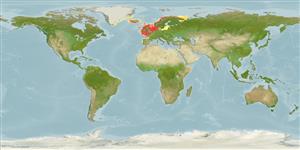Actinopterygii (ray-finned fishes) >
Pleuronectiformes (Flatfishes) >
Pleuronectidae (Righteye flounders) > Pleuronectinae
Etymology: Pleuronectes: Greek, pleura = side, ribe + Greek, nekton = swimmer (Ref. 45335). More on author: Linnaeus.
Environment / Climate / Range
Ecology
Marine; brackish; demersal; oceanodromous (Ref. 51243); depth range 0 - 200 m (Ref. 35388), usually 10 - 50 m (Ref. 35388). Temperate; 2°C - 15°C (Ref. 5504), preferred 12°C (Ref. 107945); 72°N - 36°N, 54°W - 45°E
Northern Sea. Reports from the Mediterranean Sea appear to be misidentifications of
P. flesus. It may have been present in some areas of the Mediterranean in the past, as a result of climatic changes related to the ice age, but at present times seem to be absent (Ref. 89040).
Length at first maturity / Size / Weight / Age
Maturity: Lm 30.8, range 24 - 42 cm
Max length : 100.0 cm SL male/unsexed; (Ref. 4705); common length : 40.0 cm TL male/unsexed; (Ref. 3397); max. published weight: 7.0 kg (Ref. 173); max. reported age: 50 years (Ref. 173)
Dorsal
spines
(total): 0;
Dorsal
soft rays
(total): 65-79;
Anal
spines: 0;
Anal
soft rays: 48 - 59. Smooth with small scales. Bony ridge behind the eyes. Upper side brown or greenish brown with irregularly distributed bright red or orange spots. The underside is white. Lateral line straight, slightly curved above pectoral fin. Dorsal fin reaching eye. More than 30 vertebrae.
Adults live on mixed bottoms, the older the deeper the occurrence; small individuals are usually seen on bathing beaches (Ref. 9988). Occurs on mud and sand bottom from a few meters down to about 100 m, at sea, estuaries and rarely entering freshwaters (Ref. 59043). Reported as resident intertidal species with homing behavior (Ref. 32612). Feed mainly on thin-shelled mollusks and polychaetes. Batch spawner (Ref. 51846). The most important flatfish for fisheries in Europe. Utilized fresh and frozen; eaten steamed, fried, boiled, microwaved and baked (Ref. 9988). Active at night in the very shallow water while day time is spent buried in the sand. Stationary for long periods, tagging experiments have shown that their spawning migrations can be long. Changes in the environmental conditions have been disadvantageous. Populations in Kattegat and Danish belts decreased in 1980's and early 1990's due to discharge of nutritive salts. Wadden sea is still an excellent nursery ground (Ref.35388).
Adult spawn when the temperature is around 6 °C (Ref. 4705).
Cooper, J.A. and F. Chapleau, 1998. Monophyly and intrarelationships of the family Pleuronectidae (Pleuronectiformes), with a revised classification. Fish. Bull. 96(4):686-726. (Ref. 30193)
IUCN Red List Status (Ref. 115185)
CITES (Ref. 94142)
Not Evaluated
Threat to humans
Harmless
Human uses
Fisheries: highly commercial; aquaculture: commercial; gamefish: yes; aquarium: public aquariums
Tools
Special reports
Download XML
Internet sources
